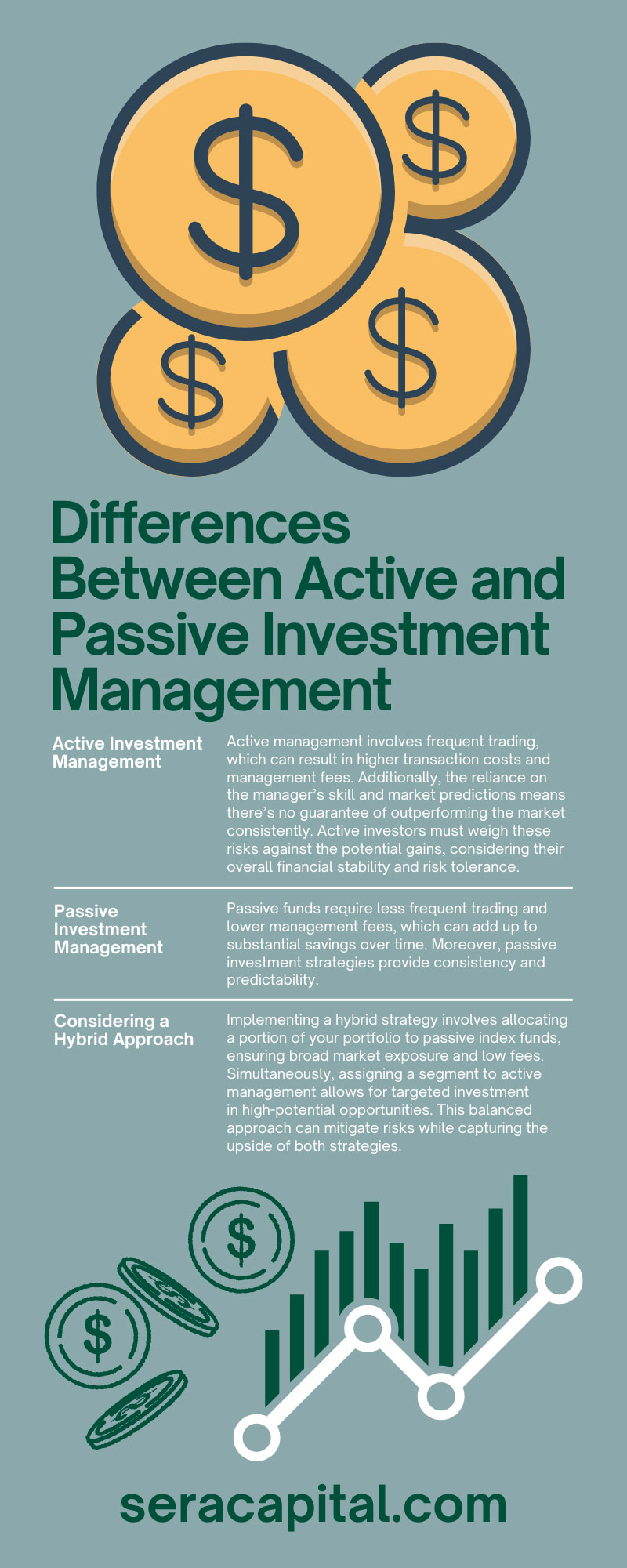Differences Between Active and Passive Investment Management

Carl E. Sera, CMT
June 21, 2024
Investment management is a critical decision for anyone who wants to put money into the market, and at the heart of this decision lies two distinct approaches: active and passive investment strategies.
Understanding these strategies is crucial for making informed choices that align with your financial goals and risk tolerance. Recognizing the differences between these approaches can significantly impact your retirement planning and other financial choices.
Today, we delve into the differences between active and passive investment management, helping you understand their benefits, drawbacks, and practical applications. Learn the nuances of these strategies today to equip yourself with the knowledge to make investment decisions that best suit your needs.
What Are Active and Passive Investments?
Active investment management involves a hands-on approach where portfolio managers make decisions about buying and selling investments. They aim to outperform the market by taking advantage of short-term price fluctuations and market inefficiencies.
On the other hand, passive investment management focuses on replicating the performance of a specific market index, such as the S&P 500. This strategy involves holding a fixed portfolio designed to match the index’s performance, emphasizing long-term growth and stability.
Both strategies are valid options to pursue, but not all investments are alike. Let’s highlight the key differences that will help you learn which investment option is right for your portfolio.
Active Investment Management
Active management can appeal to retirees and other investors seeking higher returns. Skilled portfolio managers use research, market analysis, and their expertise to make informed decisions on investment opportunities.
This proactive approach can lead to significant gains, especially in volatile markets where opportunities for substantial returns exist. However, the potential for higher returns comes with increased risks.
Active management involves frequent trading, which can result in higher transaction costs and management fees. Additionally, the reliance on the manager’s skill and market predictions means there’s no guarantee of outperforming the market consistently. Active investors must weigh these risks against the potential gains, considering their overall financial stability and risk tolerance.
Despite these challenges, active management offers the allure of personalized investment strategies. Portfolio managers can tailor their approach to suit your unique financial situation, allowing for greater flexibility and adaptability.
Passive Investment Management
Passive investment strategies offer you several compelling advantages, depending on your financial situation and overall investment goals. One of the most significant benefits is the lower fees and expenses associated with passive funds.
Passive funds require less frequent trading and lower management fees, which can add up to substantial savings over time. Moreover, passive investment strategies provide consistency and predictability.
Since these funds aim to replicate the performance of a specific index, they tend to offer more stable returns, making them a reliable choice for long-term growth. This predictability can be especially comforting for individuals who prioritize stability and a steady income stream.
Risk management is another crucial aspect of passive investment strategies. By diversifying across the entire market index, passive funds spread risk more effectively than concentrated active portfolios. This broad diversification can mitigate the impact of market downturns, preserving capital and ensuring a more secure financial future for investors.
You should now have a clearer idea of the biggest differences between active and passive investment management. That said, one of the most important details to know before investing is that you don’t have to choose between active and passive investments exclusively.
Considering a Hybrid Approach
A hybrid approach to investment management combines the strengths of both active and passive strategies. This blended strategy can offer investors the benefits of diversification and cost savings from passive funds, alongside the potential for higher returns from active management.
Implementing a hybrid strategy involves allocating a portion of your portfolio to passive index funds, ensuring broad market exposure and low fees. Simultaneously, assigning a segment to active management allows for targeted investment in high-potential opportunities. This balanced approach can mitigate risks while capturing the upside of both strategies.
For instance, a retiree may consider this path because, typically, a hybrid approach provides flexibility and adaptability. It allows for adjustments based on changing market conditions and personal financial goals. By tailoring the blend of active and passive investments, retirees can create a portfolio that aligns with their risk tolerance, time horizon, and income needs.
Factors To Consider in Choosing Between Active and Passive Management
There are many things to know broadly about passive and active investments, but there’s still an invaluable specific detail to consider—your unique financial needs and goals.
At Sera Capital, you can work with our registered financial advisors to grow and manage your portfolio how you want. That said, there’s still some vital information you should know about active and passive investment management.
When deciding between active and passive management, consider your personal risk tolerance and financial goals. Active management may suit those willing to take on higher risk for the chance of superior returns, while passive strategies appeal to those prioritizing stability and lower costs.
Your time horizon is another critical factor. Those with a shorter investment horizon may prefer the predictability of passive funds, ensuring steady income and capital preservation. Conversely, those with a longer horizon might benefit from the growth potential of active management, provided they can withstand market volatility.
Market conditions and economic outlook also play a role. In bullish markets, active managers might exploit short-term opportunities, whereas passive funds offer stability during downturns. Understanding these dynamics can help you make informed decisions about your investment strategy.
Choosing Your Management Solution
Active management offers the potential for higher returns but comes with increased risks and costs. Passive strategies provide consistency, lower fees, and effective risk management, making them a reliable choice for long-term growth.
A blended approach can offer the best of both worlds, balancing the benefits of active and passive management. For further research, seek professional advice tailored to your unique financial situation. Financial advisors can provide personalized recommendations, helping you navigate the complexities of investment management.
As you plan for your financial future, remember that the right investment strategy can significantly impact your financial security. Stay informed, weigh your options carefully, and choose the approach that aligns with your goals and risk tolerance.
Your financial well-being in retirement depends on making educated and strategic investment decisions right now. Don’t hesitate to schedule a free consultation with our experts at Sera Capital today.

Categories
Strategize Your Success
